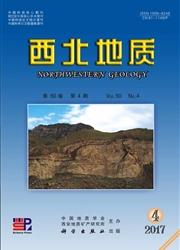

 中文摘要:
中文摘要:
北疆地区不同构造单元内分布大量的镁铁-超镁铁质岩体,含铜镍硫化物矿化的岩体集中于早二叠世。含铜镍岩体顶与底的识别是一世界性难题,而对深部矿与隐伏矿的勘查十分重要。根据这些镁铁-超镁铁岩体地表出露面积大小和岩相期次,可分为大岩体(大于5~40km^2)、小复式岩体(1~3km^2)和单式岩体(小于0.1km^2)三类。三类岩体在岩体形态、产状、岩相构成、超镁铁质岩相所占比例、赋矿岩相、矿体空间分布以及矿石中Cu/Ni值等方面都有所不同。根据岩体和矿化的基本特征,结合矿物粒度、蚀变强弱、有无同期玄武岩、辉绿岩等,可以综合判定岩体的相对剥蚀程度与埋深。相对剥蚀程度结合区域上元素化探异常和地球物理异常的细微差别,可作为评价镁铁超镁铁岩体的铜、镍成矿潜力的有力工具。镁铁质岩墙、小岩体、小岩体群、产于大辉长岩体中的小的超镁铁岩露头,强烈蚀变的镁铁-超镁铁岩区,重磁异常区,物化探异常叠加区等均是今后北疆寻找小岩体大矿床的重点靶区。
 英文摘要:
英文摘要:
The Northern Xinjiang is characterized by a large number of Permian mafic-ultramafic complexes with magmatic Cu-Ni sulfide mineralization in different tectonic unit. The identification of the top and bottom of these Cu-Ni sulfide-bearing mafic-ultamafic intrusions, a worldwide problem, is significant for the blind ore exploration. According to the outcrop area and lithofacies, these complexes can be divided into large complex (〉18-40 km^2), small complex massif (1-5 km^2) and simple rock-body (〈 0. 1 km^2) . The three types differ in body size, occurrence, lithofacies, the ratio of mafic and ultramafic bodies, ore-bearing lithology, space distribution of orebody and the ratio of Cu/Ni in orebody. The above- mentioned essential features of the complexes and mineral grain, alteration degree, basalt and diabase coeval with mafic-ultramafic intrusions, can determine the relative erosion degree of the deposits synthetically. The relative erosion degree in combination with the regional element geochemical and geophysics anomalies, are the effective measures to evaluate the Cu-Ni mineralization potential in mafic-ul- tramafic complexes. Mafic dykes, small intrusion, ultramafic outcrop in large mafic-ultramafic complex, strongly altered mafic-ultramafic intrusive rocks, gravity and magnetic anomaly zone superimposed geochemical anomalies, are the important target for finding small intrusion with large scale magmatic Cu- Ni sulfide deposits.
 同期刊论文项目
同期刊论文项目
 同项目期刊论文
同项目期刊论文
 Magma source and tectonics of the Xiangshanzhong mafic-ultramafic intrusion in the Central Asian Oro
Magma source and tectonics of the Xiangshanzhong mafic-ultramafic intrusion in the Central Asian Oro Geochronologic-petrochemical studies of the Hongshishan mafic-ultramafic intrusion, Beishan area, Xi
Geochronologic-petrochemical studies of the Hongshishan mafic-ultramafic intrusion, Beishan area, Xi Petrological features and implications for mineralization of the Poshi mafic-ultramafic intrusion in
Petrological features and implications for mineralization of the Poshi mafic-ultramafic intrusion in Late Paleozoic mafic–ultramafic intrusions in southern Central Asian Orogenic Belt (NW China): Insig
Late Paleozoic mafic–ultramafic intrusions in southern Central Asian Orogenic Belt (NW China): Insig Geochemistry and geochronology of acidic rocks in the Beishan region, NW China: Petrogenesis and tec
Geochemistry and geochronology of acidic rocks in the Beishan region, NW China: Petrogenesis and tec Petrogenesis and mineralization of the Hulu Ni-Cu sulphide deposit in Xinjiang, NW China: constraint
Petrogenesis and mineralization of the Hulu Ni-Cu sulphide deposit in Xinjiang, NW China: constraint SIMS ZIRCON U-Pb GEOCHRONOLOGY AND Sr-Nd ISOTOPES OF Ni-Cu-BEARING MAFIC-ULTRAMAFIC INTRUSIONS IN EA
SIMS ZIRCON U-Pb GEOCHRONOLOGY AND Sr-Nd ISOTOPES OF Ni-Cu-BEARING MAFIC-ULTRAMAFIC INTRUSIONS IN EA Petrological, geochemical and geochronological constraints on the origin of the Xiadong Ural-Alaskan
Petrological, geochemical and geochronological constraints on the origin of the Xiadong Ural-Alaskan Petrogenesis and ore genesis of the Permian Huangshanxi sulfide ore-bearing mafic-ultramafic intrusi
Petrogenesis and ore genesis of the Permian Huangshanxi sulfide ore-bearing mafic-ultramafic intrusi The Early Permian mafic–ultramafic complexes in the Beishan Terrane, NW China: Alaskan-type intrusiv
The Early Permian mafic–ultramafic complexes in the Beishan Terrane, NW China: Alaskan-type intrusiv Olivine compositional mapping of mafic-ultramafic complexes in eastern Xinjiang (NW China): Implicat
Olivine compositional mapping of mafic-ultramafic complexes in eastern Xinjiang (NW China): Implicat Subduction-induced mantle heterogeneity beneath Eastern Tianshan and Beishan: insights from Nd-Sr-Hf
Subduction-induced mantle heterogeneity beneath Eastern Tianshan and Beishan: insights from Nd-Sr-Hf Occurrence of an Alaskan-type complex in the Middle Tianshan Massif, Central Asian Orogenic Belt: In
Occurrence of an Alaskan-type complex in the Middle Tianshan Massif, Central Asian Orogenic Belt: In Multiple stages of magma emplacement and mineralization of eastern Tianshan, Xinjiang: Examplified b
Multiple stages of magma emplacement and mineralization of eastern Tianshan, Xinjiang: Examplified b Geochemistry and zircon U-Pb geochronology of Getashankou mafic-ultramafic intrusions, eastern Tians
Geochemistry and zircon U-Pb geochronology of Getashankou mafic-ultramafic intrusions, eastern Tians The role of crustal contamination in the formation of Ni-Cu sulfide deposits in Eastern Tianshan, Xi
The role of crustal contamination in the formation of Ni-Cu sulfide deposits in Eastern Tianshan, Xi 期刊信息
期刊信息
